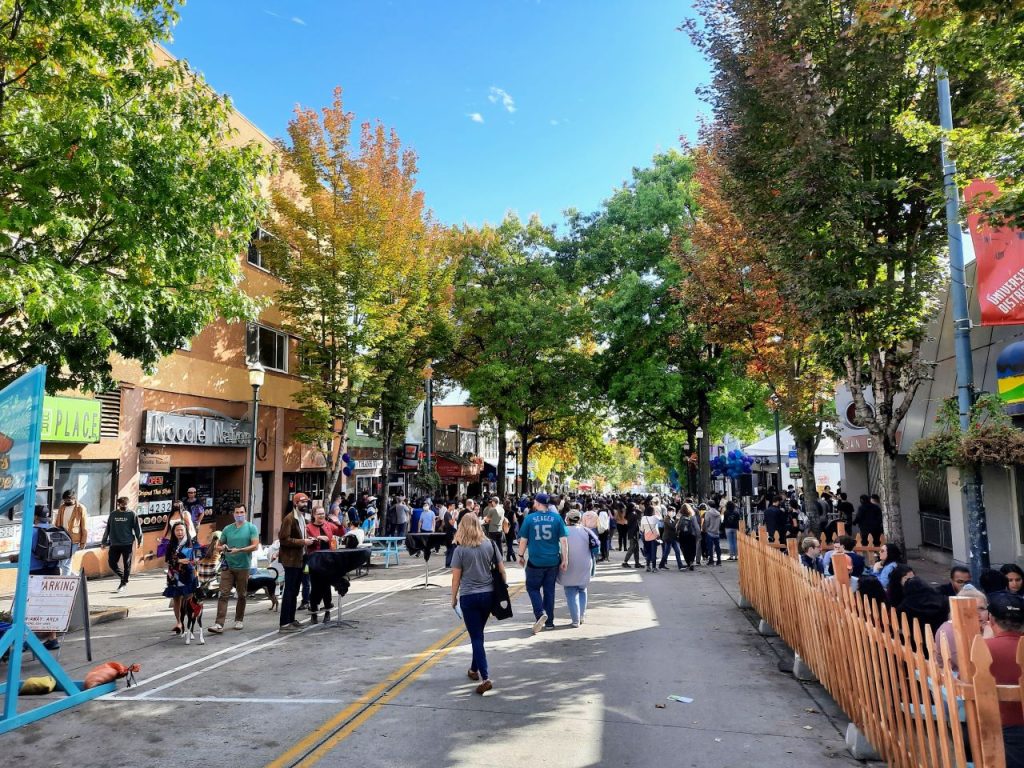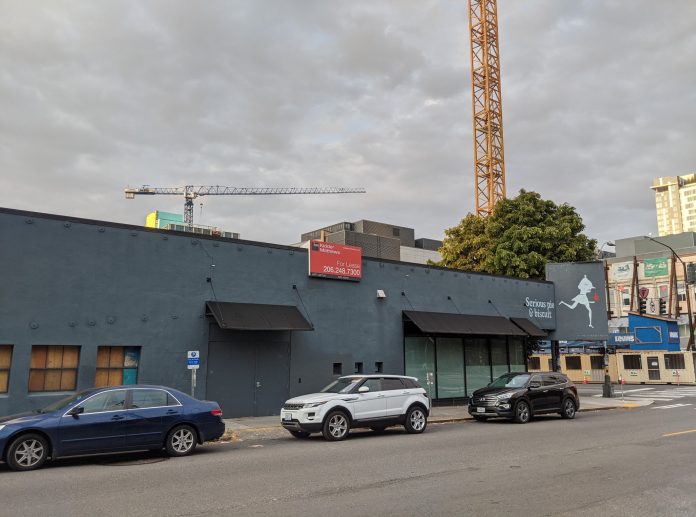In a bid to reactivate Downtown Seattle, Mayor Bruce Harrell is proposing additional legislation to fill vacant storefronts by allowing a much wider range of uses. Newly permitted uses would run the gambit from crafting studios, greenhouses, medical offices, classrooms, art installations, public restrooms, and research laboratories
The legislation will make changes to the City’s labyrinthine Land Use Code and help realize another plank of the Mayor’s Downtown Activation Plan (DAP) announced last year.
“Optimizing our built environment with diverse business types will encourage a constant flow of people traveling throughout our city core to shop, eat, enjoy arts and culture events, play and work. As our city continues to evolve, our regulations must also, and this proposal allows us to be nimble as we create a downtown for today and the future,” Mayor Harrell said in a statement on Thursday.
The Harrell administration is bullish that these code tweaks could open up opportunities for significant new business or cultural ventures to take off.
“Today’s vacant storefront has the potential to become the next thriving restaurant, research lab, art installation, medical office or retail shop that meets the needs of our communities,” Harrell said. “These changes are another critical step in ensuring Downtown, Belltown, South Lake Union and Uptown have a variety of goods and services available and a vibrant atmosphere for residents and visitors alike.”
Under the City’s Land Use Code, regulations for street-level uses can be highly restrictive. Depending upon the zone and street designation type, the Land Use Code often calls for highly active uses for most if not all street frontage spaces, such as salons, apparel stores, coffeeshops, bars, and tutoring centers. Things like printing and crafting studios, most offices, and higher education institutions aren’t currently allowed under street-level regulations.
With a high level of remote work since the pandemic, office districts throughout the city have seen many storefronts go vacant, even as some workers have returned to their cubicles some or all days of the workweek. Commercial real estate firm Kidder Matthews pegged the retail vacancy rate in Downtown Seattle at 12.7% in the fourth quarter of 2023, compared to the 2% to 3% rate generally found in suburban areas, according to the Puget Sound Business Journal.
Meanwhile, the office vacancy rate in Downtown Seattle was nearly 24% and nearly 17% citywide in the same timeframe according to Kidder Matthews — significantly higher than the pre-pandemic vacancy level of 10%.
The lack of occupied storefronts and office worker foot traffic to help sustain the storefronts that do remain contribute to broader issues that urbanists spend a lot of time theorizing about. Jane Jacobs notes vacant or inactive buildings means fewer “eyes on the street,” lowering perceptions of safety and security. Councilmember Bob Kettle (whose District 7 covers Downtown and Queen Anne) alluded to this effect in his statement as he noted the proposal would “improve our public safety posture.”
Shuttered businesses can also make districts less “sticky” — a fancy way of saying people don’t want to be there or linger, causing remaining businesses to suffer. Danish architect and urbanism guru Jan Gehl even postulated a door ratio threshold for a block that some have referred to as the Gehl Door Average that separates a highly sticky, vibrant, and successful commercial block from a boring, move-it-along one with few active storefronts. For Seattle, more filled storefronts would mean a higher door average, bringing ancillary benefits like spillover foot traffic and a sense of vibrancy.

In recognition of the vacancy issue, the City previously adopted interim regulations in 2021 to permit more flexibility for street-level uses. Mayor Harrell’s proposed legislation is fairly similar to those pandemic-era regulations, but would generally apply to more neighborhoods within Downtown Seattle, South Lake Union, and Uptown — though not in historic and special review districts. In addition to any required street-level uses, the legislation would allow for a wide variety of uses on certain blocks, including:
- Office and research and development laboratory uses;
- Food processing, craft work, and horticulture uses;
- Medical services uses (not including hospitals);
- Public restrooms and art installation uses;
- Schools and colleges; and
- Accessory spaces for residential and lodging uses.
Administrators of the City’s Land Use Code would also have flexibility to allow other types of uses if there is a “likelihood of attracting and increasing pedestrian activity in the area such as extending the duration of activity beyond 8am to 5pm Monday to Friday or increasing the variety of goods and services available,” according to the draft legislation.
Along with the allowance for more uses, the legislation would make technical changes to more easily locate street-level uses, such as exemptions to floor area ratio standards and minimum depth of street-level uses, and encourage uses on the second floor of buildings.
According to a City report, specific streets that could especially benefit from the changes include:
- “1st, 2nd, and 3rd Avenues in Belltown, portions of 3rd Avenue through 8th Avenue and Union Street and Olive Way in the retail core vicinity and Denny Triangle, and 1st, 2nd, and 4th Avenues in the commercial core;”
- “The 5th Avenue N corridor and portions of Mercer Street” in Uptown; and
- “The northern portion of South Lake Union — near Westlake Avenue, Mercer Street, and Valley Street.”
The legislation is designed to expire after three years, so property owners would have a reasonable period of time to apply for changes to street-level uses. And the legislation would allow any approved uses to continue as legally non-conforming if the provisions aren’t further extended down the road. So the legislation wouldn’t require a change back to more active uses if and when it sunsets.
The Seattle Department of Construction and Inspections (SDCI) is pledging extra assistance to navigate the City’s permitting process, which has developed a reputation of being a gauntlet.
“Regulatory flexibility is an important tool in supporting economic vitality and allowing smaller-scale businesses to improve the quality of our downtown neighborhoods,” SDCI Director Nathan Torgelson said in a statement. “In full support of Mayor Harrell’s Downtown Activation Plan, my department is poised to provide prioritized permit assistance for any business seeking to fill a vacant storefront Downtown.”
Whether the proposal provides enough of a nudge to fill out Seattle’s vacant storefronts remains to be seen. It could be that other hurdles like remodeling costs, permitting snags, and fees could hinder the conversion of empty storefronts — not to mention the larger economic headwinds facing brick-and-mortar retail, with increased competition from online shopping, a tight labor market, and foot traffic still being down from pre-pandemic levels downtown.
Earlier this month, Mayor Harrell proposed related legislation with commercial-to-residential use conversion incentives through the City’s Land Use Code. When the Seattle City Council will take up that legislation and this new street-level use legislation remain unclear, but the previous city council did adopt Mayor Harrell’s suite of Downtown rezones last fall to facilitate more highrise residences and hotels along Third Avenue and in Belltown.
Doug Trumm is publisher of The Urbanist. An Urbanist writer since 2015, he dreams of pedestrian streets, bus lanes, and a mass-timber building spree to end our housing crisis. He graduated from the Evans School of Public Policy and Governance at the University of Washington in 2019. He lives in Seattle's Fremont neighborhood and loves to explore the city by foot and by bike.


